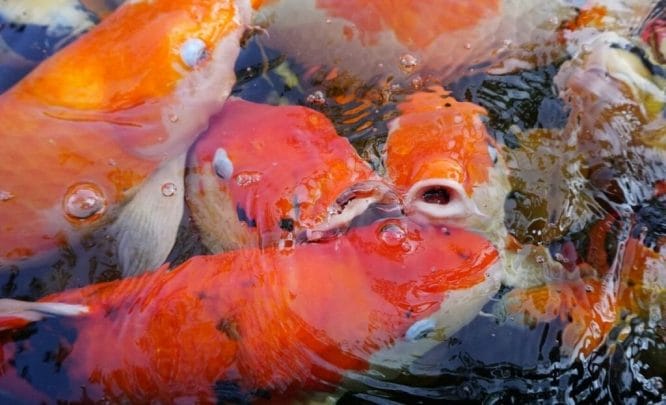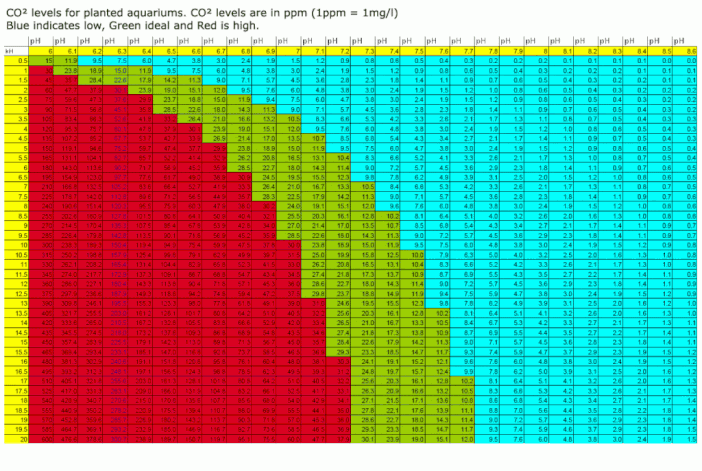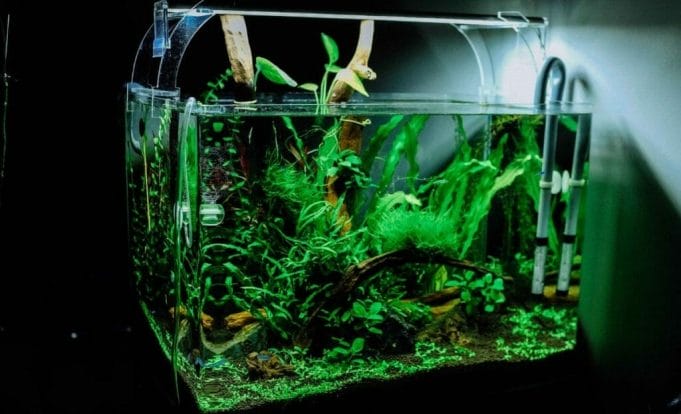CO2 is one of the most important gases in your fish tank.
If your aquarium has too much or too little CO2 in your tank then it can affect the health of the fish and plants in your aquarium.

Table of Contents
Is CO2 harmful to fish?
Too much CO2 is harmful to fish. For most fish, a CO2 level of 30 PPM (Parts Per Million) is safe.
However, exactly how much CO2 is safe for the fish in your aquarium is dependent on other factors such as the species of the fish and KH, pH, and O2 levels in the water of your aquarium.
Why is too much CO2 harmful to fish?
A concentrated amount of co2 in a fish tank hinders the capacity of hemoglobin to carry oxygen in fish.
This causes suffocation, gasping, and even low immunity in fish.
Besides, when there is a lot of co2 present in the aquarium the pH in the aquarium drops.
Now, this can cause issues if the pH is not in the ideal range that the fish in your tank need.
Because of all these reasons, too much CO2 is dangerous to fish.
20 Tips to Maintain a Healthy Aquarium
How to test CO2 level in an aquarium?
There are a couple of ways to test CO2 in your aquarium.
1. pH and KH relation
To test CO2 using this method, you have to take readings of the pH and KH level in your aquarium which you can easily do using a test kit.
To test the pH of the water in your aquarium you can use API Aquarium Test Kit. Check its reviews and price at Amazon here.
To test KH you can use API GH and KH Test kit. Check its reviews and price at Amazon here.
Once you’ve got the readings then you have to use the chart shown below to know the co2 levels in your aquarium.

(source)
If the readings come in the red part then it shows that the co2 level in your tank is very high.
If the reading comes in in the green part then it shows that the co2 is in the ideal range i.e. it is not too much for the fish.
And if the reading comes in the blue part then it shows that your aquarium has a low level of CO2.
A few drawbacks of measuring CO2 levels using pH and KH relation method
There a few reasons why using the pH and KH relation method to determine the co2 level in your tank can be misleading.
1. First of all, to determine the co2 level using this method you are relying on taking accurate readings of pH and KH in your aquarium.
So if the readings are not accurate then this will impact the co2 readings in your aquarium.
2. Secondly, this method is considering only CO2 as an acid that will affect the pH level in your tank. Basically, when CO2 goes into the aquarium it gets converted into carbonic acid and that creates the pH level to drop in your aquarium.
However, if you have a mature aquarium then there are already some other acids like nitric acid and humic acid present in the aquarium that can affect the pH level.
So when you consider only co2 as an acid in your aquarium and don’t consider other acids that are affecting the pH levels in your aquarium then this can mislead you about the actual co2 levels in your aquarium.
Tips to Take Care of Live Plants in Aquarium (For Beginners)
2. CO2 drop checker
Using a drop checker is a modern way of measuring CO2 levels in your aquarium.
A drop checker is basically a small glass device that contains a pH reagent known as Bromothymol blue.
As the name suggests, it is a blue liquid.
When you put the co2 drop checker in your aquarium, the CO2 gas in your aquarium will react with the reagent and this will change its color depending on the CO2 concentration in your tank.
If the blue color changes to yellow it suggests that your aquarium has too much CO2 (more than 30 PPM).
If the blue color changes to a darker blue then it suggests that your aquarium does not have optimum CO2.
If your aquarium has optimum CO2 levels then the color of the reagent changes to lime green or dark green color.
And this is the color you should aim for.
A few drawbacks of using CO2 checker
Though a CO2 drop checker does give you pretty accurate CO2 readings, it does take 3 to 4 hours to change the color.
Basically, the more the gap is between the reagent and the aquarium water. And the more the quantity of reagent present in the drop checker the longer it will take to change the color of the reagent.
If you have a large tank then you’ll also need to put multiple CO2 drop checkers at different places in your tank to know if the co2 is distributed throughout the aquarium or not.
Are Aquarium Plant Fertilizers Safe For Fish?
Signs of too much CO2 in an aquarium

The signs of too much CO2 in your aquarium are as follows:
1. Fish behavior
If you notice that your fish are coming to the surface of the water of your tank gasping for air very frequently then it suggests that your fish and struggling to get oxygen.
This is because when there is too much CO2 in an aquarium, it affects the ability of hemoglobin to carry oxygen in fish.
Besides, fish becomes lethargic if there is too much CO2 in the aquarium.
2. Drop checker
If the liquid in your drop checker turns yellow then it shows that your aquarium has too much CO2.
3. pH and KH ratio
If the pH and KH readings of the water of your aquarium come in the red part of the table below then it shows that your aquarium has too much CO2.

(source)
How to lower the CO2 levels in a fish tank?
If you noticed signs of high CO2 levels in your tank then there are a few ways you can lower the co2 levels in your tank and save your fish!
1. Large water change
If you noticed high CO2 levels in your tank then you should quickly do a large water change of up to 50% of your aquarium water.
Also, make sure that the water you are going to add in your tank is dechlorinated. And it has a similar temperature as the water in your aquarium.
Because chlorine is harmful to fish and too much or low temperature of the water can shock the fish in your aquarium.
You can easily dechlorinate the water using a dechlorinator which you can find at your local fish store or online on Amazon here.
2. Adjust the needle valve
If you are using a CO2 system in your aquarium then you can easily reduce this CO2 injection by adjusting the needle valve.
Does CO2 Reduce Algae in Aquarium?
3. Aerate the tank
When there is a concentrated amount of co2 present in an aquarium the fish struggle to get oxygen.
So aerating the tank can help to increase the oxygen level in the water in your aquarium.
You can easily aerate the fish tank using an Air pump.
I recommend Tetra Whisper air pump you can check its latest price and reviews at Amazon here.
52 Best Freshwater Aquarium Plants For Beginners (And Care Guide)
Precautions to take to keep CO2 level under control if you are using a CO2 system

CO2 systems are great!
They exponentially speed up the growth and enhance the coloration of aquarium plants in your aquarium.
However, if you don’t handle the co2 properly then it will do more bad than good to your aquarium.
If the co2 levels rise above 30 PPM in your aquarium then it can harm the fish in your tank and ultimately can lead to the death of the fish in your tank.
That’s why keeping CO2 levels under control is very important in a fish tank.
There are a few precautions you can take to keep the co2 levels under control in your aquarium.
1. CO2 drop checker
If you are not already using it then you should definitely put a co2 drop checker in your aquarium.
If you have a larger tank then you may need to put multiple drop checkers at different locations in your aquarium. So you can know if the co2 is getting distributed throughout your aquarium or not.
The co2 drop checker will continuously monitor the co2 levels in your tank.
And, in case your aquarium has too much CO2, the liquid in the co2 drop checker will turn yellow.
2. Don’t run CO2 24/7
Many beginners make this make mistake. They run the CO2 in their aquarium 24/7 which kills the fish in their tank.
This is because the plants absorb CO2 when they get light, but when there is no light they start absorbing Oxygen and start releasing Carbon dioxide.
So, at night time, when the lights are off in your tank, the plants will release CO2 in your aquarium.
And, at this time, if you are also running the co2 in your aquarium then a lot of co2 will build up in your aquarium which will suffocate the fish and it can lead to the death of the fish in your tank.
So how long should you run CO2 in your aquarium?
Most experts run CO2 about 1 hour before turning on the lights in the morning. And they shut down the co2 supply one hour before turning off the light.
The ideology behind this practice is that when you don’t run CO2 throughout the night there is not an optimum level of co2 present in the aquarium.
So when you turn on the co2 1 hour before turning on the light, CO2 will build up in your aquarium.
And when the aquarium lights will kick in, the plants will start absorbing CO2 right away.
On the other hand, at night time, shutting down the co2 supply 1 hour before turning off the light is a good idea because by this time there is a lot of co2 present in the aquarium.
So there is already a sufficient amount of co2 present in the aquarium for plants to absorb in that one hour.
14 Best Fast Growing Aquarium Plants (without CO2)
Conclusion
Overall, too much co2 (more than 30 PPM) is not safe for fish. And if your tank contains too much co2 for a long time then it can lead to the death of the fish in your aquarium.
So, you should regularly test the co2 in your fish tank. And also watch out for any signs of too much co2.
I hope I’ve answered all your questions.
If you found the article helpful then please share it.
Happy fishkeeping!